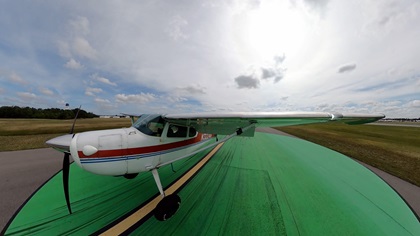A long, bumpy ride to a big green dot
AOPA Sweepstakes Cessna 170B arrives at Sun 'n Fun
A horsepower boost notwithstanding, your AOPA Sweepstakes Cessna 170B’s journey south from Maryland to Florida took a bit longer than it otherwise might, and nothing says “general aviation” like a weather diversion.
AOPA once again tapped veteran sweepstakes prize relocation specialist (and social media marketer by day) Erick Webb for the obviously important mission of delivering the classic Cessna with its fearsome (and very recent) engine upgrade to the Sun 'n Fun Aerospace Expo.
Compared to those aviation adventures, the trip to Sun 'n Fun, while shorter in terms of distance, left a few things to be desired, namely favorable wind and weather. Winds were 12 knots gusting to 18 knots when Webb, having waited as long as possible for a break in the conga line of nasty storms marching across the country, took off on March 26 at 6:15 a.m.
“It was turbulent right off the bat,” Webb recalled in a debrief. The brand-new, 195-horsepower Continental Prime IO-370 engine driving a Hartzell Trailblazer propeller adds punch aplenty when it comes to getting off the ground, but the combination is less helpful in cruise flight over long distances into strong headwinds. Groundspeed, Webb reported with what may have been a barely audible sigh, never broke 105 mph as the Continental purred along at 23-squared, burning 10 gallons per hour or less. The Alaskan Bushwheel tires are handy on rough terrain, but draggy on a deadline.
Other upgrades proved more beneficial: Webb used SiriusXM Aviation weather to avoid the worst of what was passing from west to east along his course south. Captured by a Garmin GDL 52 portable ADS-B receiver, the weather information proved very useful for maintaining true VFR conditions throughout, Webb said, particularly when picking a path from North Carolina to Georgia, though first came an unplanned stop 80 miles short of plan, due to headwinds, at Ashe County Airport in Jefferson, North Carolina. Further progress south was temporarily halted at Asheville Regional Airport (the originally planned fuel stop), where the weather remained VFR, with much worse ahead.
Webb waited a few hours, thinking ahead to St. Simons Island Airport in Georgia, where a hotel bed was conveniently waiting adjacent to the FBO. Webb recalled that the restaurants on St. Simons Island were not the incentive they might otherwise be, given his habit of avoiding large meals late at night, and it was getting late. His heightened weather awareness eventually allowed him to safely reach Georgia on the tail end of a stormy day with just "a few drops of rain on the airplane." Some of the weather to the south included storm cells with tornadic activity, but the situation improved on March 27.
Webb was wheels-up by 8 a.m. for the final leg to Lakeland Linder International Airport, where a crowd was building quickly. While a few clouds remained, including a thin marine layer along the Florida coast, the rest of the trip was much smoother, in terms of turbulence, than the kidney-pounding adventure over the Blue Ridge Mountains, Webb recalled.

The low-and-slow sojourn over central Florida culminated in the standard arrival in effect for Sun 'n Fun, a busy day for any pilot but old hat by now to Webb, who touched down precisely as instructed (and captured a photo to prove it) just after the green dot painted on Runway 28R. The flights south added 10.4 hours to the Hobbs for a trip that might have been done in 8 hours with more favorable weather.
“Thank you, headwinds,” Webb said, summing up the overall experience, inclusive of turbulence and slow groundspeed, in one word: “excruciating.”
“You can print that,” he added.







